Visiting Bairro Alto is a highlight of any trip to Lisbon. In this guide, I’ll tell you what are the best things to see and do in this neighborhood!
Bairro Alto, which literally translates to “upper neighborhood”, is one of the oldest and most famous neighborhoods in Lisbon. By day, it attracts tourists who want to see its historical architecture and nearby landmarks.
At night, though, Bairro Alto really transforms into a nightlife hotspot. With numerous bars, restaurants and live music venues, this neighborhood pulsates with music as locals and tourists party the night away.
From street-side cafés and cultural activities to bars and clubs, Bairro Alto invites everyone to have a unique and memorable experience. And, today, I’ll tell you everything you need to know to make the most of your visit to this neighborhood. Let’s dive in!
Index
- Main attractions in Bairro Alto
- Nightlife in Bairro Alto
- How to get to Bairro Alto?
- Tips for an authentic experience
- History
- Architecture
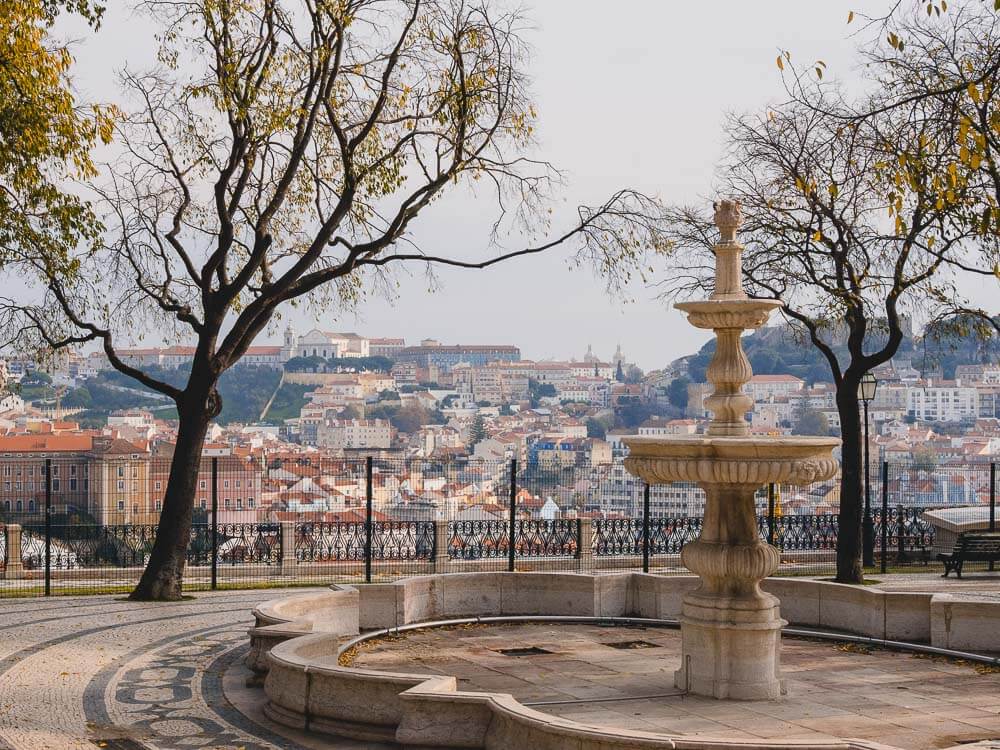
1. Main attractions in Bairro Alto
As one of the main neighborhoods in Lisbon, there are a lot of things to do both in Bairro Alto itself and in the area that surrounds it. Trust me, you won’t have a moment of boredom while exploring its charming streets.
Of course, having too many options means it can be a bit overwhelming to narrow down which attractions you want to see… But don’t worry, I’m here to help you! That’s why I’ll share my list of the things you just can’t miss while visiting Bairro Alto. Ready? Let’s go!
1.1. São Roque Church
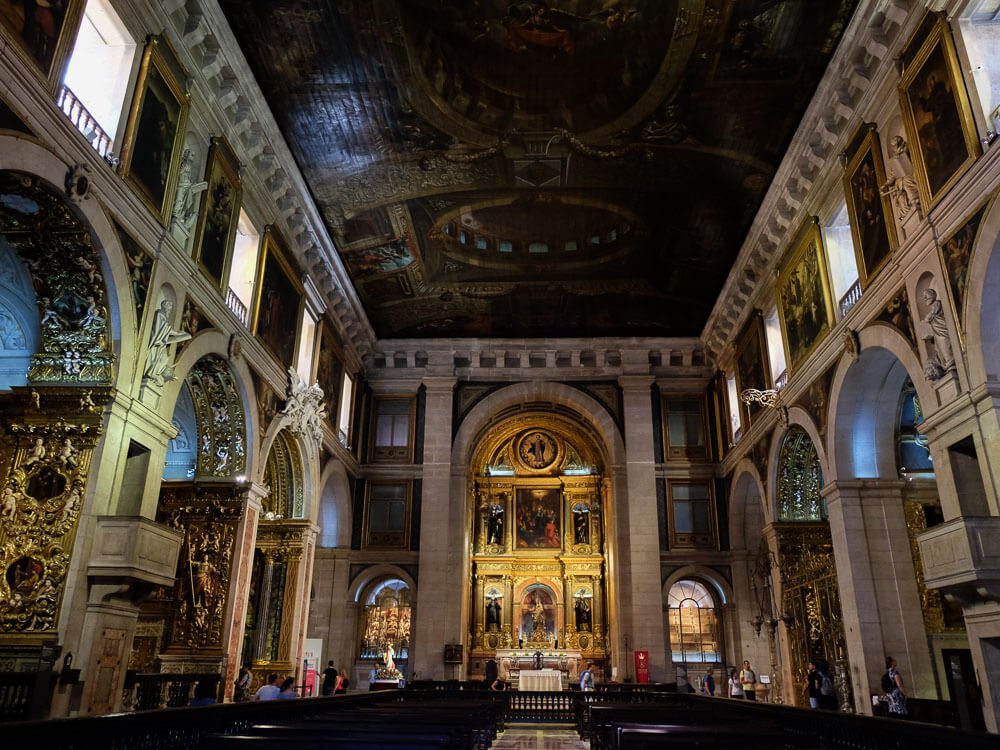
The Church of São Roque, in the Bairro Alto neighborhood, has been a big part of Lisbon’s history for centuries. Built in 1533, it was the first Jesuit church of the city, and continues to be an important site for both spiritual and cultural activities.
From the outside, the church may look pretty simple, but once you step inside, it’s a whole different story! The interior is very ornate and detailed, featuring marbles, golden stucco work, painting and beautiful azulejo panels.
Amongst its interiors, one of the highlights is the Chapel of St. John the Baptist. Its construction started in 1740, in Rome, and it was blessed by the pope before being shipped to Lisbon, piece by piece, and reassembled inside the Church of São Roque. This chapel is known as one of the most valuable chapels in the world, featuring materials such as ivory, agate, lapis lazuli and gold.
1.2. Santa Catarina Church
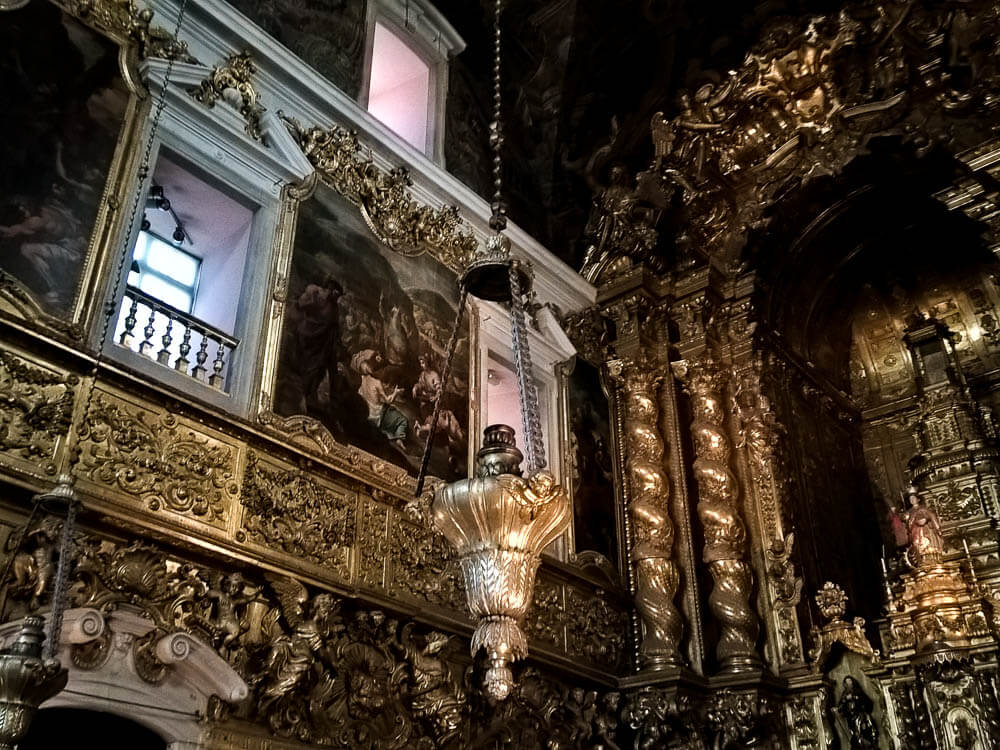
Also known as Igreja dos Paulistas, the Santa Catarina Church used to be part of a convent back in 1647 and is an extraordinary example of a building that survived the 1755 earthquake, giving visitors a rare glimpse into the 18th century Portuguese opulence.
Though its exterior is quite plain and simple, once you step inside you’ll see one of the most stunning examples of baroque architecture in Lisbon. The ceiling showcases Rococo stucco work from the 18th century with gilded elements completed in 1727, considered one of the best in Europe.
On the walls, you’ll find paintings by Vieira Lusitano and André Gonçalves, both renowned Portuguese Baroque artists. Besides that, you’ll also get to see a huge organ, a true masterpiece of gilded woodwork, and an altarpiece featuring sculptures of Saint Catherine, Saint Paul and Saint Anthony.
Even though it’s not as famous as other landmarks in Lisbon, Santa Catarina Church is definitely worth a visit!
1.3. Convento de São Pedro de Alcântara

This convent, located in Bairro Alto and founded in 1670, was another of the few buildings that only suffered minor damage during the 1755 earthquake. It overlooks one of Lisbon’s most beautiful viewpoints, the Miradouro de São Pedro de Alcântara (which I’ll tell you more about in the next topic!).
The Convento de São Pedro de Alcântara was inspired by 17th-century palaces and is shaped like a U, with a church nestled between the two wings. There, you’ll find an impressive decoration from 1758, including an altar and gilding with plant motifs. The paintings are the oldest items and originally belonged to a convent in Mafra.
The highlights include the massive oil painting of the Holy Trinity by the French artist Pierre-Antoine Quillard, and 18th-century blue-and-white tile panels on the walls, which showcase scenes from the life of St. Peter of Alcantara. The Chapel of Lencastre is also notable for its detailed marble decoration, which survived the earthquake unscathed.
You can visit the church for free, or go on a guided tour that provides access to more areas within the convent complex. A must-visit for any history and architecture lover!
1.4. Miradouro de São Pedro de Alcântara
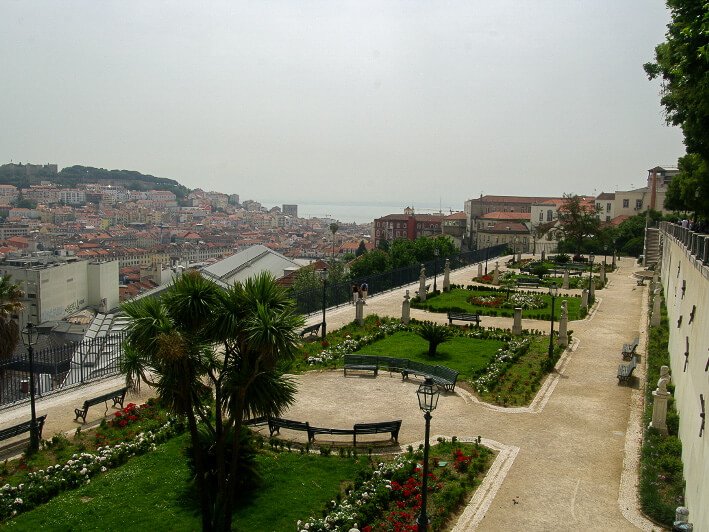
The Miradouro de São Pedro de Alcântara is known for its great views of the city, and it’s very popular among both locals and tourists alike. Here, you’ll find landscaped terraces with sculptures and even a kiosk so you can enjoy a drink while taking in the beautiful skyline.
Besides offering great views of the Tagus River, this miradouro also allows you to see some of the most important landmarks of the city, including São Jorge Castle, Lisbon Cathedral and São Vicente de Fora Monastery.
And it’s not only during the day that this miradouro is a popular choice. Lots of people also go there during the night, to see all the city lights. It’s a totally different experience, and one that I highly recommend!
1.5. Miradouro de Santa Catarina

Miradouro de Santa Catarina is another very popular spot in the Bairro Alto neighborhood, offering great views of the city’s port. Ideal for both solo travelers or groups, this spot is perfect for chilling out and enjoying a drink from the nearby kiosk-café.
This miradouro is busiest towards the end of the day, when people gather to watch the sunset and take in the views of the city as it lights up. Its relaxed vibe reflects Bairro Alto’s charm, and it’s no wonder it’s a favorite among locals and tourists.
Besides the awesome sunset views, the café often plays music, adding to the laid-back vibe where you can easily lose track of time while enjoying the scene and some good company. If you’re strolling through Bairro Alto, make sure to swing by Miradouro de Santa Catarina for the views and a taste of local life!
1.6. Elevador da Bica

The Elevador da Bica is a famous tram that goes up the steep Rua da Bica, one of the most pictured streets of Lisbon. Operating since 1892, this tram has been a real lifesafer for people traveling from the waterfront of the Tagus River to the Bairro Alto neighborhood above.
Not only are these bright yellow trams a handy way to navigate the slope, they also offer great views of the river and historical buildings adorned with traditional azulejos. That’s why, while it still serves its main purpose, over time the Elevador da Bica has become a hit with tourists who want to experience a bit of Lisbon’s transportation history.
The trams run every day until 9 pm, departing every 15 minutes, so you won’t have any trouble fitting it into your Lisbon plans! And, trust me, you don’t want to miss out on it.
The Elevador da Bica not only provides a convenient way of transportation, but also connects you with a piece of history that’s still a part of everyday life in the city.
1.7. Elevador da Glória
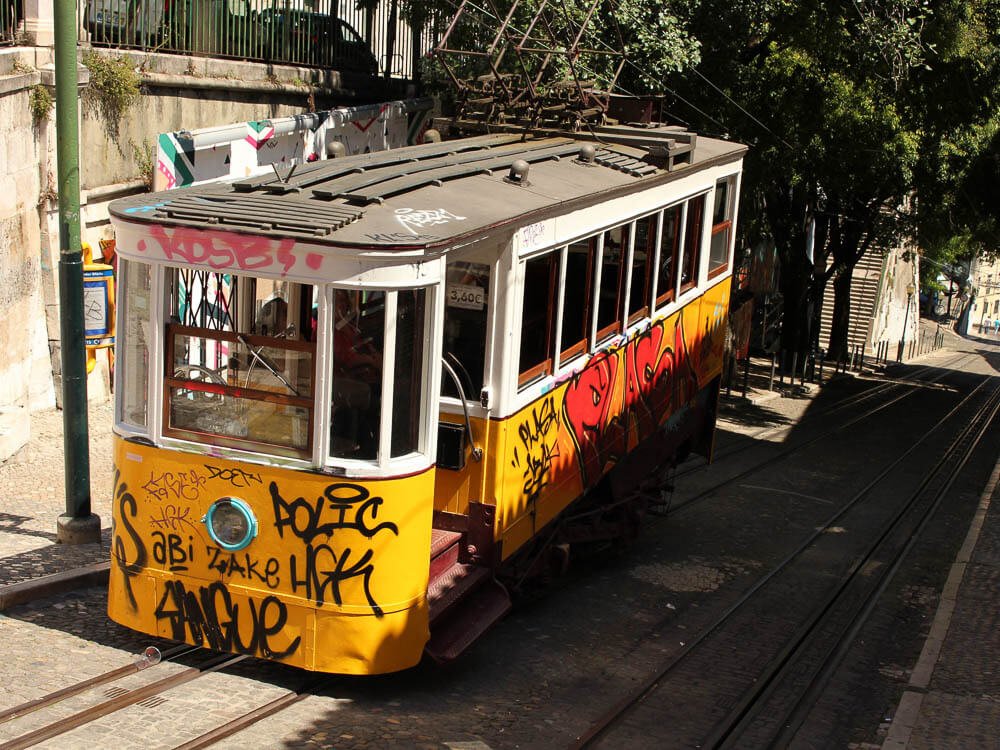
The Elevador da Glória, which started running in 1885, is a tram that takes people from Restauradores Square to the Bairro Alto neighborhood. It’s been a crucial way to get around Lisbon’s hilly terrain for both locals and tourists.
But it’s not just about getting from A to B; the Elevador da Glória is a piece of Lisbon’s history. At the Bairro Alto stop, there’s a street art display with seven panels made by local artists. Put up by the City Council in 2008, this gallery blends right into the neighborhood and shows how public spaces can be used for art.
You’ll often spot graffiti on the Elevador da Glória’s once-yellow exterior, which tends to spark debates about preserving history versus artistic freedom. Either way, the ever-changing art reflects the city’s current cultural scene, and is worth taking some time just to see it!
2. Nightlife in Bairro Alto
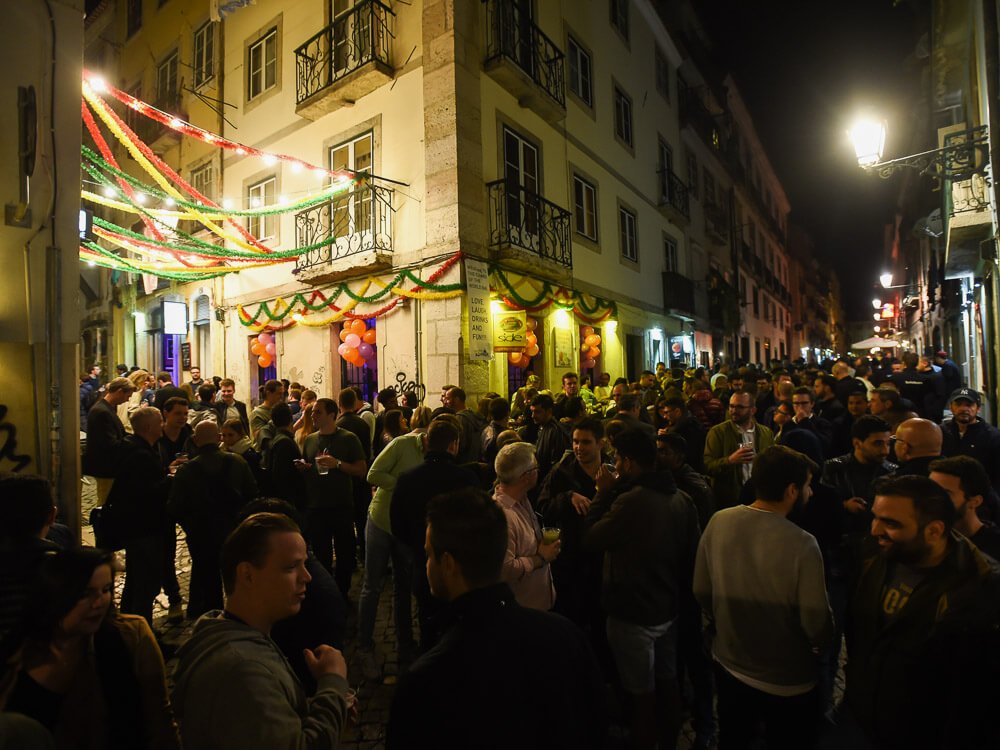
When night falls, Bairro Alto transforms from a historic area into the busiest nightlife spot in Lisbon. The cobblestone streets fill up with locals and tourists, and there’s no shortage of bars, clubs, and live music spots for all tastes.
Because of Bairro Alto’s layout, most places are close by, making it easy to hop between places. In fact, the bar scene often spills onto the streets, creating a laid-back and social atmosphere. In one moment, you could be sipping Portuguese wine at a Fado house and in another dancing at a club. That’s what makes this place so fun!
At night, Bairro Alto really shows off why Lisbon is famous for its entertainment scene: it’s where cultural experiences meet socializing, lasting until the early hours. Whether you’re a nightlife enthusiast or just looking to do something different, you can count on this neighborhood to surprise you!
2.1. Fado in Bairro Alto
Recognized by UNESCO as cultural heritage, Fado is a key aspect of Bairro Alto’s character, especially in the evening. Going to a Fado house will give you an opportunity to immerse yourself in Portuguese culture and tradition, getting to know this music genre that originated in the streets of Alfama.
There are plenty of intimate venues in Bairro Alto waiting for your visit with skilled Fadistas, traditional Portuguese cuisine and delicious wines. And, even though the best way to discover them is by exploring the neighborhood’s narrow streets, I won’t leave you without any recommendations. So, here they are: O Faia, Adega Machado, and Café Luso.
You can thank me later!
3. How to get to Bairro Alto?
Getting to Bairro Alto is pretty easy no matter where you are in the city. If you want to go up to the upper part, just hop on the Glória funicular from Restauradores Square and it will take you straight up the hill and right into the neighborhood.
For the lower area of Bairro Alto, near Praça Luís de Camões, you can easily walk from Baixa-Chiado metro station. This makes it convenient for visitors to check out downtown and Chiado before heading up to Bairro Alto.
If you prefer a scenic route through old streets, you can either take Tram 28 or the Bica funicular from near the river. Regardless of how you get there, Bairro Alto will blow you away with all the different things to do and see there!
4. Tips for an authentic experience
If you want to experience Bairro Alto just like a local, the first thing I recommend is that you explore it on foot. Walking truly is the best way to discover its narrow streets and appreciate the unique details of the neighborhood.
The second tip I have for you is to dine in a traditional Portuguese tavern, also known as tasca. That way, you’ll get a more authentic experience and be able to taste local foods just like a lisboeta.
Another very traditional thing you just must do when visiting Bairro Alto is to attend a Fado show. At night, there are live performances happening all over the neighborhood, a testament to Portugal’s history that you have to witness for yourself.
This leads me to my last tip for an authentic experience in Bairro Alto: visit during the night! Seriously. You should see Bairro Alto during both the day and the night at least once in your life. While the days are peaceful and quiet, the night turns it into something else completely.
Even if you’re not really a partier, you’ll definitely find something for you there! It’s the ultimate way to get to a taste of the Lisbon lifestyle, as this is where most locals flock to have a drink with their friends.
5. History of Bairro Alto
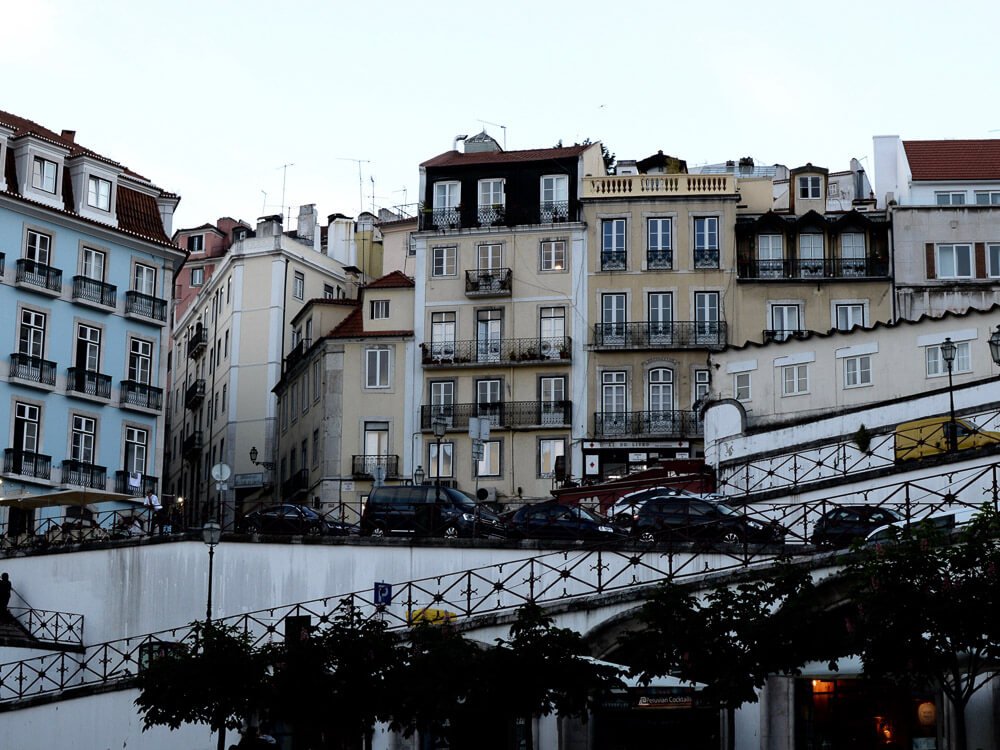
Bairro Alto’s history dates back to the late 15th century, during Lisbon’s expansion from maritime explorations. Originally, the district was home to aristocrats and merchants seeking a quieter area above the busy city center.
After the 1755 earthquake, the neighborhood’s residential status was reaffirmed while Marquis de Pombal led the neighborhood’s reconstruction and introduced more consistent building structures that could better withstand future seismic events.
In the 19th century, numerous shops and newspapers set up their offices in Bairro Alto, transforming the area into a commercial hub. It started being associated with a bohemian lifestyle, full of social and cultural dynamism, and attracting intellectuals and artists.
Today, Bairro Alto is a fascinating blend of historical charm and modernity during the day, while at night it transforms into the most exciting part of Lisbon’s nightlife. Not only will you find old buildings with contemporary shops, traditional taverns and fado houses, but also numerous bars and clubs where locals and tourists party until the sun comes up.
6. Architecture of bairro alto
The Bairro Alto is a notable example of urban planning from the Renaissance. Its grid pattern layout was a departure from the irregular medieval city designs, and greatly influenced later urban planning in Lisbon.
The oldest buildings in this neighborhood are from the 16th and 17th centuries, and, despite the destruction caused by the earthquake of 1755, Bairro Alto’s robust construction on stable ground helped it withstand significant damage.
During the reconstruction post-earthquake, Marquis de Pombal introduced what became known as Pombaline architecture, which aimed at improving earthquake resistance. This style also brought aesthetic changes, with Neoclassical influences and more restrained decorations, such as geometric patterns on buildings.
Which side of Bairro Alto are you most excited about?
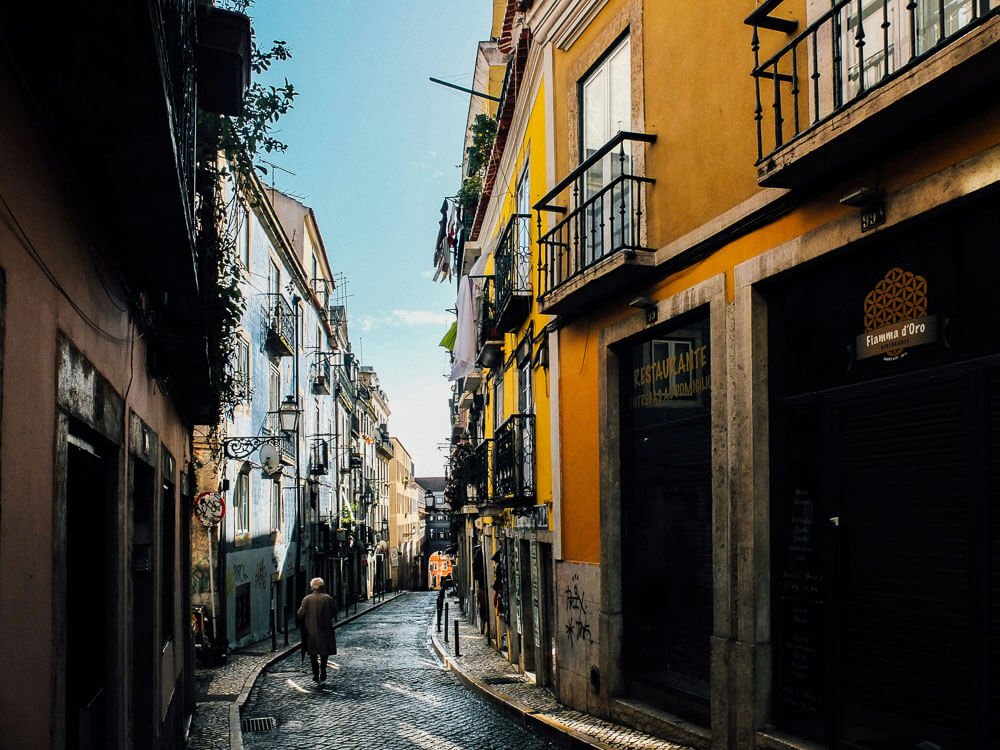
Bairro Alto is more than a historic neighborhood in Lisbon, it’s a place to explore local culture, art, and enjoy the renowned nightlife that attracts so many people from all over the world.
Besides being close to several attractions, Bairro Alto’s narrow alleys, traditional shops and architecture are the perfect place to get lost in during the day. Meanwhile, the night brings out a totally different side of Lisbon, with numerous bars, restaurants and Fado houses adding to its after dark charm.
With so many things to do and see in Bairro Alto, I’m sure everyone will find something of interest there, whether it’s a nice bar or a historical building. Just make sure not to miss out on the opportunity to visit this neighborhood and discover for yourself why it’s so famous!







